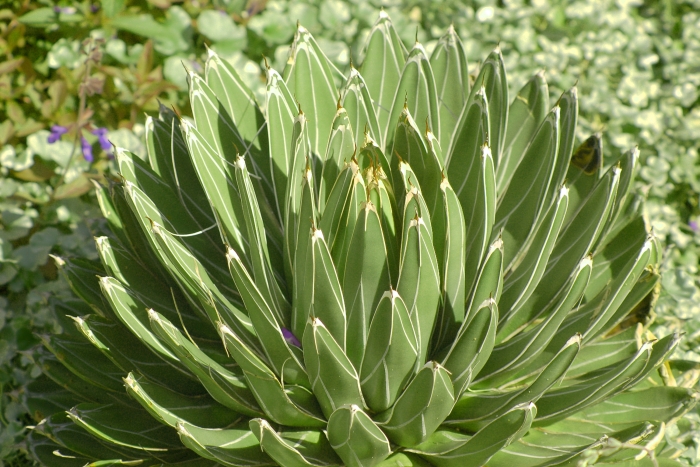Royal Agave
(Agave victoriae-reginae)
Royal Agave (Agave victoriae-reginae)
/
/

(c)2006 Derek Ramsey (Ram-Man). Chanticleer Garden
CC BY-SA 3.0
Image By:
(c)2006 Derek Ramsey (Ram-Man). Chanticleer Garden
Recorded By:
Copyright:
CC BY-SA 3.0
Copyright Notice:
Photo by: (c)2006 Derek Ramsey (Ram-Man). Chanticleer Garden | License Type: CC BY-SA 3.0 | License URL: http://creativecommons.org/licenses/by-sa/3.0/ | Uploader: Rotatebot | Publisher: Wikimedia Commons | Title: Agave_victoriae-reginae_Plant_3000px.jpg | Notes: {{Information |Description= |Source=self-made |Date= |Author= [[User:Rob Hille|Rob Hille]] }} |




























Estimated Native Range
Summary
Agave victoriae-reginae, commonly known as Royal Agave, is an evergreen succulent native to the Chihuahuan Desert in Northeastern Mexico. It typically grows to a height of 0.5 meters, forming a compact rosette of short, rigid, thick leaves that are dark green with distinctive white markings resembling a network of fine lines. The Royal Agave blooms infrequently, but when it does, it produces cream-colored flowers on erect racemes that can reach up to 4 meters in length, although flowering is rare in cultivation. This species is one of the more cold-hardy agaves, making it suitable for cultivation in regions with milder winters.
The Royal Agave is valued for its sculptural form and striking leaf patterns, making it a popular choice for rock gardens, xeriscaping, and as a focal point in succulent collections. It is also used as an ornamental houseplant. While it can tolerate some cold, in the UK and other regions with harsh winters, it is recommended to overwinter the plant indoors or under glass. For optimal growth, it should be planted in very porous, sandy soil to ensure good drainage and prevent root rot. The soil should be allowed to dry out completely between waterings. Direct sunlight or bright shade is ideal for maintaining the vibrant leaf coloration. Repotting is necessary only every two to three years, and propagation is typically done by seed, as the plant seldom produces offsets. The Royal Horticultural Society has recognized its horticultural merit with an Award of Garden Merit. Potential problems include root rot if overwatered and mealybugs or scale insects.CC BY-SA 4.0
The Royal Agave is valued for its sculptural form and striking leaf patterns, making it a popular choice for rock gardens, xeriscaping, and as a focal point in succulent collections. It is also used as an ornamental houseplant. While it can tolerate some cold, in the UK and other regions with harsh winters, it is recommended to overwinter the plant indoors or under glass. For optimal growth, it should be planted in very porous, sandy soil to ensure good drainage and prevent root rot. The soil should be allowed to dry out completely between waterings. Direct sunlight or bright shade is ideal for maintaining the vibrant leaf coloration. Repotting is necessary only every two to three years, and propagation is typically done by seed, as the plant seldom produces offsets. The Royal Horticultural Society has recognized its horticultural merit with an Award of Garden Merit. Potential problems include root rot if overwatered and mealybugs or scale insects.CC BY-SA 4.0
Plant Description
- Plant Type: Succulent
- Height: 1-2 feet
- Width: 1-2 feet
- Growth Rate: Slow
- Flower Color: N/A
- Flowering Season: Summer
- Leaf Retention: Evergreen
Growth Requirements
- Sun: Full Sun, Part Shade
- Water: Low, Very Low
- Drainage: Fast, Medium
Common Uses
Bee Garden, Bird Garden, Border Plant, Deer Resistant, Drought Tolerant, Fire Resistant, Hummingbird Garden, Low Maintenance, Potted Plant, Rabbit Resistant, Rock Garden, Salt Tolerant, Showy Flowers, Street Planting
Natural Habitat
Chihuahuan Desert
Other Names
Common Names: Queen Victoria Agave, Königs-Agave, Drottningagave
Scientific Names: , Agave victoriae-reginae,
GBIF Accepted Name: Agave victoriae-reginae T.Moore